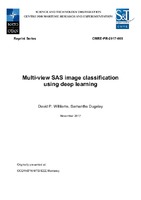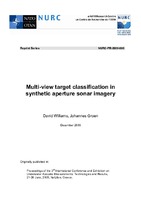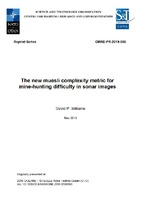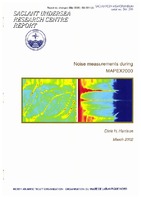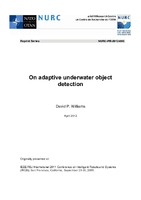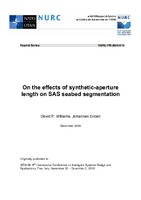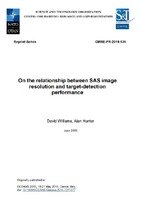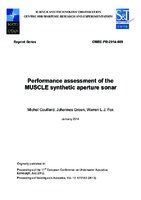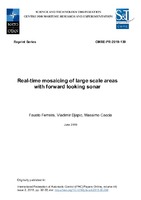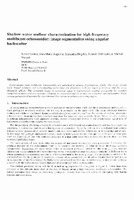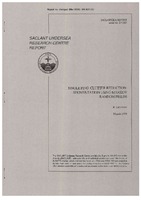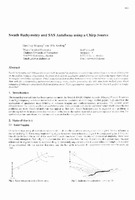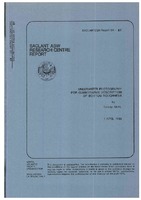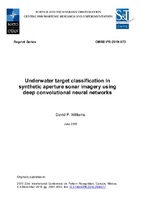Browsing by Subject "Image processing"
Now showing items 21-35 of 35
-
Multi-view SAS image classification using deep learning
(CMRE, 2017/11)A new approach is proposed for multi-view classification when sonar data is in the form of imagery and each object has been viewed an arbitrary number of times. An image-fusion technique is employed in conjunction with a ... -
Multi-view target classification in synthetic aperture sonar imagery
(NURC, 2009/12)This work proposes an elegantly simple solution to the general task of classifying the shape of an object that has been viewed multiple times. Specifically, this problem is addressed in the context of underwater mine ... -
The new muesli complexity metric for mine-hunting difficulty in sonar images
(CMRE, 2019/05)A new image complexity metric has been developed that fuses the concept of lacunarity, a measure of pixel intensity variation, with the notion of spatial information, a quantity that captures edge energy. This new metric, ... -
Noise measurements during MAPEX 2000
(NATO. SACLANTCEN, 2002/03)During MAPEX2000 some simultaneous ambient noise measurements with an HLA and satellite SAR images were collected. The aim was to predict shipping and wind noise from the satellite radar and to compare results with acoustic ... -
On adaptive underwater object detection
(NURC, 2012/04)A new algorithm for the detection of underwater objects in sonar imagery is proposed. One particularly novel component of the algorithm also detects the presence of, and estimates the orientation of, sand ripples. The ... -
On the effects of synthetic-aperture length on SAS seabed segmentation
(NURC, 2009/12)In this work, we quantify the relationship between synthetic-aperture length (or equivalently, along-track resolution) and seabed segmentation performance experimentally for real synthetic aperture sonar (SAS) imagery. The ... -
On the relationship between SAS image resolution and target-detection performance
(CMRE, 2019/06)The relationship between synthetic aperture sonar (SAS) image resolution and target-detection performance is quantified. It is first demonstrated how a lower-resolution SAS system can be simulated in a principled manner ... -
Performance assessment of the MUSCLE synthetic aperture sonar
(CMRE, 2014/01)Synthetic Aperture Sonar (SAS) systems are quickly becoming fundamental tools for seabed mapping applications, as they provide high resolution imagery independent of range from the sensor, with high area coverage rates. ... -
Real-time mosaicing of large scale areas with forward looking sonar
(CMRE, 2019/06)Mosaicing of large scale areas is an important application in the field of underwater computer vision. Although most of the works use optical cameras for that purpose, Forward Looking Sonars, also called acoustic cameras, ... -
Shallow-water seafloor characterization for high-frequency multibeam echosounder: image segmentation using angular backscatter
(NATO. SACLANTCEN, 1997)Sonar images from multibeam echosounders are submitted to various degradations, partly due to the sensor itself: Signal artefacts and corresponding corrections are presented, both for signal processing and for array ... -
Single ping clutter reduction: segmentation using Markov random fields
(NATO. SACLANTCEN, 1999/03)The use of low frequency active sonar in shallow water leads to large numbers of clutter detections. This high false alarm rate can overload automatic tracking and classification algorithms. Traditional detection algorithms ... -
Swath bathymetry and SAS autofocus using a Chirp source
(NATO. SACLANTCEN, 1997)Swath bathymetry and SAS autofocus can both be treated as problems in correlating echoes from a scatterer distribution on the seabed. Using a chirp source, the phase derived from quadrature match-filtering can replace the ... -
Underwater photography for quantitative description of bottom roughness
(NATO. SACLANTCEN, 1985/04)Knowledge of the roughness of the sea floor is obviously of great importance in marine geology for understanding the processes of the ocean bottom, and in underwater acoustics for understanding the scattering process. The ... -
Underwater target classification in synthetic aperture sonar imagery using deep convolutional neural networks
(CMRE, 2019/06)Deep convolutional neural networks are used to perform underwater target classification in synthetic aperture sonar (SAS) imagery. The deep networks are learned using a massive database of real, measured sonar data collected ... -
Wavelet analysis of side scan sonar imagery for classification
(NATO. SACLANTCEN, 1997)Wavelet-based techniques are presented for compressing side scan sonar images communicated from UUV's through band limited communication channels. Testing with an automatrc classifier on reconstructed images demonstrates ...
